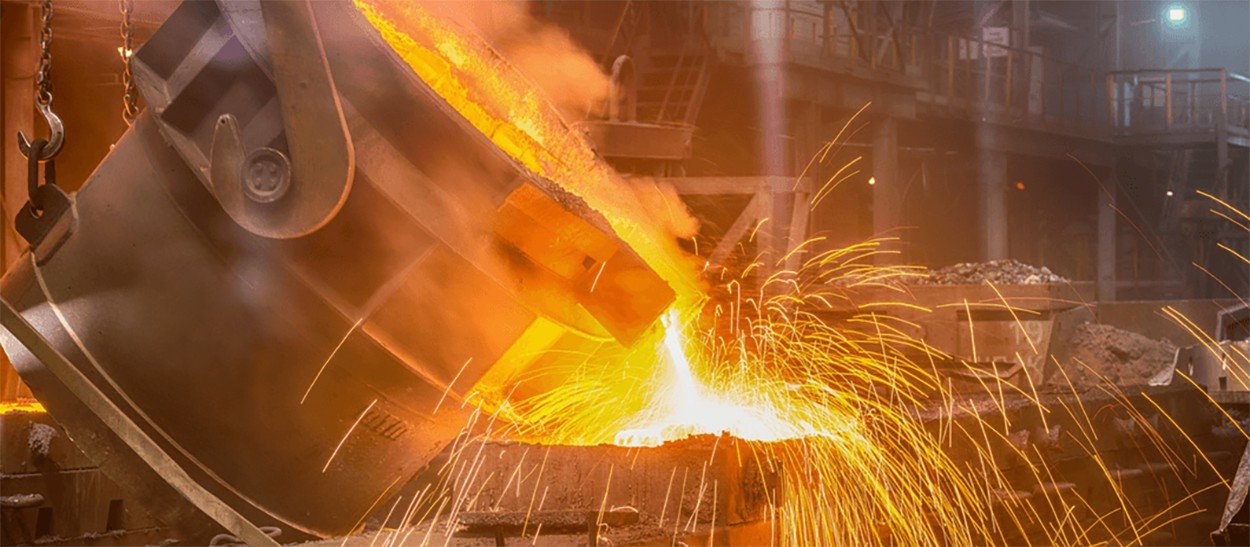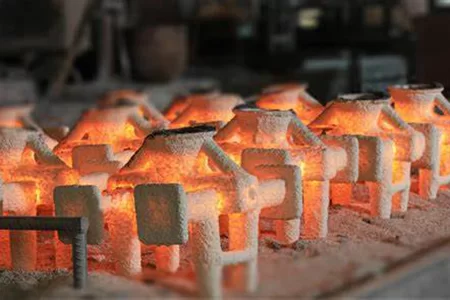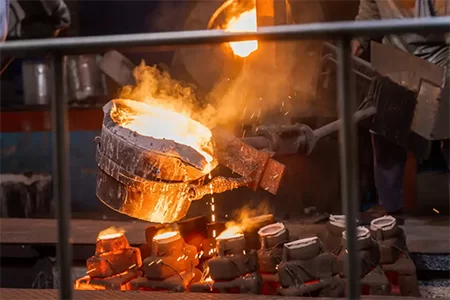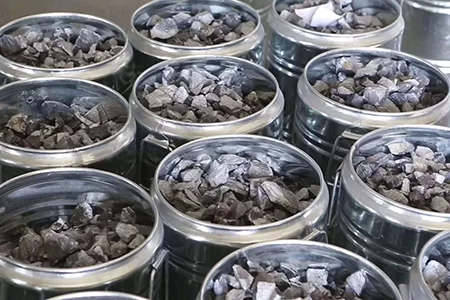
What Are The Metal Casting Materials Commonly Used in Foundries?
-
Home>
-
Blog>
-
Technology>
What Are The Metal Casting Materials Commonly Used in Foundries?
In the field of metal processing, casting is an important means. It is widely used in many industries because it can transform metal materials into parts of various shapes and specifications. The choice of casting materials plays a decisive role in the quality, performance and production cost of the final castings. There are many kinds of casting materials commonly used in foundries, and each material has a unique scope of application, selection criteria, advantages and disadvantages. Let's summarize them below!

Cast Iron
Scope of Application
Cast iron is a "jack of all trades" in the industrial field and is widely used in the manufacture of most mechanical parts, such as the bed of machine tools and the gears of gearboxes. These parts need to have certain strength and wear resistance, which cast iron can meet well. In terms of pipeline manufacturing, whether it is urban water supply and drainage pipelines, or industrial pipelines, cast iron ensures the stable operation of the pipeline system with its good corrosion resistance and strength. Automotive engine parts, such as cylinder blocks and cylinder heads, also use cast iron materials in large quantities because they can withstand the high temperature and high pressure when the engine is working. Typical materials include gray cast iron, ductile iron, and malleable cast iron, each of which has unique performance characteristics and application scenarios.
Selection Criteria
When selecting cast iron materials, strength, hardness, wear resistance and corrosion resistance are the main considerations. For parts that withstand high pressure, high temperature resistance and complex shapes, such as engine cylinder blocks, ductile iron is a good choice, which combines the good casting performance of cast iron with high strength and toughness. For some pipelines with high requirements for corrosion resistance, specially treated cast iron materials will be selected.
Advantages and Disadvantages
Low cost is a significant advantage of cast iron. Its raw materials are affordable, and the casting process is relatively simple, without complex processes and expensive equipment, which makes large-scale production possible and reduces production costs. Good casting performance is also one of its highlights, and it can easily cast parts with complex shapes to meet various design requirements. Ductile iron, in particular, has excellent strength and toughness, even surpassing steel in some aspects. However, cast iron is not perfect. Some types, such as gray cast iron, are brittle and prone to cracking when subjected to excessive impact force, which limits its application in some occasions that require high impact toughness. At the same time, its resistance to high temperature and high pressure is relatively poor, and its mechanical properties will be significantly reduced under high temperature and high pressure environments.

Aluminum Alloy
Scope of Application
In the automotive, aviation, electronic products and other industries that pursue lightweight and high performance, aluminum alloy has become the preferred material for lightweight structural parts. In automobile manufacturing, aluminum alloy is widely used in engine cylinders, wheels, body structural parts, etc., which effectively reduces the weight of the car and improves fuel economy and handling performance. The aviation field is an important application scenario for aluminum alloys. Aluminum alloys are used in large quantities in aircraft wings, fuselages and other parts to reduce aircraft weight, improve flight performance and fuel efficiency. In electronic products, aluminum alloys are often used to make shells, which can not only reduce product weight, but also provide good heat dissipation performance and appearance texture.
Selection Criteria
Weight, corrosion resistance and thermal conductivity are key considerations when selecting aluminum alloys. When producing parts with extremely high requirements for lightweight and good corrosion resistance, aluminum alloy is undoubtedly one of the best choices. Different aluminum alloy grades will differ in these properties and need to be selected according to specific needs.
Advantages and Disadvantages
The biggest advantage of aluminum alloy is its lightweight and low density, which makes it incomparable in applications that need to reduce weight. Excellent corrosion resistance is also a highlight. In humid or corrosive environments, aluminum alloy can remain stable for a long time and is not easily damaged by corrosion. Good thermal conductivity makes it play an important role in applications that require efficient heat dissipation, such as radiators and cooling systems. However, aluminum alloy also has some shortcomings. Its strength is lower than that of materials such as steel, and it may not meet the requirements when bearing heavy loads. Moreover, at high temperatures, the performance of aluminum alloy is not as stable as steel and is prone to softening, which limits its application in high temperature environments.

Copper Alloy
Scope of Application
Copper alloys are widely used in electronics, heat exchangers, ship parts and other fields due to their unique properties. In the field of electronics, copper alloys are widely used in the manufacture of wires and cables, pins of electronic components, connectors, etc. due to their excellent electrical conductivity, ensuring the efficient transmission of electronic signals. Heat exchangers are another important application field of copper alloys. With their good thermal conductivity, efficient heat transfer can be achieved, and they are widely used in air conditioning and refrigeration equipment. In shipbuilding, copper alloys are often used to manufacture propellers, valves, pipes and other parts because they have excellent corrosion resistance in seawater environments.
Selection Criteria
Electrical conductivity, corrosion resistance and wear resistance are the main criteria for selecting copper alloys. When the application environment has high requirements for electrical conductivity or corrosion resistance, copper alloys become an ideal choice. Different copper alloy compositions and ratios will make them focus on these properties, and they need to be selected according to the specific use environment and needs.
Advantages and Disadvantages
Excellent electrical conductivity and thermal conductivity are the outstanding advantages of copper alloys, which makes it widely used in electrical equipment and heat exchangers. In terms of corrosion resistance, copper alloys perform well in seawater or chemical corrosion environments and can maintain stable performance for a long time. Good machinability is also one of its advantages. Whether it is casting or machining, copper alloys can easily cope with it and meet the manufacturing needs of various complex-shaped parts. However, the cost of copper alloys is relatively high, especially the high price of high-purity copper, which to a certain extent limits its large-scale application. In addition, its strength is low, and it is not very suitable in environments that are subjected to excessive impact.
Carbon Steel
Scope of Application
Carbon steel is the preferred material for mechanical parts with high bearing capacity requirements. Engine parts, such as crankshafts and connecting rods, need to withstand huge mechanical stress and impact force. Carbon steel can work reliably with its high strength and good toughness. In the field of construction, carbon steel is widely used in building structural parts, such as steel beams and steel columns, to support the skeleton of high-rise buildings and ensure the stability and safety of buildings. Key components of transportation tools, such as automobiles, trains, and ships, also use a large amount of carbon steel to meet their bearing and operation requirements.
Selection Criteria
Strength, toughness, wear resistance and processability are the key factors to consider when selecting carbon steel. In the field of high load, high temperature resistance and corrosion resistance, it is necessary to select the appropriate type and grade of carbon steel according to the specific working conditions. For example, heat-resistant carbon steel will be used for parts working in high temperature environments; weathering carbon steel will be used for parts working in corrosive environments.
Advantages and Disadvantages
High strength and wear resistance are the significant advantages of carbon steel. It can withstand large loads and ensure the long-term stable operation of parts under harsh working conditions. Good processability is also a major feature of carbon steel. Its structure and performance can be changed through various methods such as heat treatment and cold processing to meet the requirements of precision manufacturing. In high temperature environments, the performance of carbon steel is relatively stable and can meet the needs of high temperature operations. However, carbon steel also has some disadvantages. In humid or corrosive environments, carbon steel is prone to rust and corrosion, which requires additional protective measures such as painting and galvanizing. In addition, high-strength carbon steel often requires greater power and special processing technology during processing, which increases production costs.

Stainless Steel
Scope of Application
Stainless steel plays an irreplaceable role in industries such as medical equipment, food processing, and chemical equipment that have extremely high requirements for corrosion resistance. In the field of medical equipment, stainless steel is used to manufacture surgical instruments, implants, etc. Its excellent corrosion resistance and biocompatibility ensure the safe use of equipment and human health. In the food processing industry, stainless steel equipment and containers can ensure the sanitation and safety of food and will not cause pollution to food. Chemical equipment needs to have a high degree of corrosion resistance under the erosion of various chemical media, and stainless steel can meet this requirement well.
Selection Criteria
Corrosion resistance, strength and toughness are the main considerations for selecting stainless steel. When the application environment requires long-term corrosion resistance, different types and grades of stainless steel have differences in corrosion resistance, strength, etc., and need to be selected according to specific corrosive media, temperature, pressure and other conditions.
Advantages and Disadvantages
The biggest advantage of stainless steel is its excellent corrosion resistance. It can maintain stable performance for a long time in harsh environments such as humidity, acid and alkali corrosion, and is not easily damaged by corrosion. High temperature resistance is also one of its highlights. It has good stability at high temperatures and is suitable for various equipment and parts in high temperature environments. At the same time, stainless steel has high strength, good toughness, and can withstand large loads. However, the cost of stainless steel is relatively high, and its raw material price and processing cost are higher than those of ordinary steel. Moreover, compared with ordinary steel, the processing and welding of stainless steel is more difficult and requires special processes and equipment.
Magnesium Alloy
Scope of Application
Magnesium alloy has shown unique advantages in fields such as aerospace and automobiles that have extremely strict requirements for lightweight. In the field of aerospace, magnesium alloys are used in aircraft internal structural parts and engine parts, which can significantly reduce the weight of aircraft, improve flight performance and fuel efficiency. In automobile manufacturing, magnesium alloys can be used to manufacture engine cylinders, gearbox housings, wheels and other parts to achieve lightweight automobiles, reduce energy consumption and emissions.
Selection Criteria
Lightweight, strength and corrosion resistance are key factors in selecting magnesium alloys. For industries with strict weight requirements, magnesium alloys are ideal materials for lightweighting on the premise of meeting strength and certain corrosion resistance requirements. Different magnesium alloy grades have different properties in these properties and need to be selected according to specific application scenarios.
Advantages and Disadvantages
The extremely light nature of magnesium alloys makes it a leader in the field of lightweighting and one of the lightest structural metal materials, especially suitable for fields with strict weight requirements. At the same time, it has a high strength-to-weight ratio, which can effectively reduce the weight of components and meet the needs of lightweight structures while ensuring a certain strength. However, magnesium alloys have poor corrosion resistance and are easily corroded in environments with high moisture and salt content, which requires special protective measures such as surface treatment. In addition, its production cost is high and its processing requirements are relatively strict, which to some extent limits its large-scale application.

Nickel Alloy
Scope of Application
Nickel alloy plays an important role in many key fields due to its excellent comprehensive performance. In the field of aerospace, it is often used to manufacture hot end parts of jet engines, such as turbine blades, combustion chambers, etc. These parts need to work under extreme conditions of high temperature, high pressure and high speed. The high temperature resistance, high strength and oxidation resistance of nickel alloy can ensure the reliable operation of the engine. In the field of energy, nickel alloy is used for reactors, pipelines, valves, etc. in petrochemical equipment, because it can still maintain good performance under high temperature, high pressure and highly corrosive chemical medium environment, ensuring the safety and stability of petrochemical production. In addition, in the electronics industry, nickel alloy can be used to manufacture precision electronic components, such as integrated circuit pins, electronic tube parts, etc. Its good conductivity and stability help improve the performance and reliability of electronic equipment.
Selection Criteria
When selecting nickel alloy, its high temperature resistance, corrosion resistance, strength and adaptability to special environments are mainly considered. For high temperature environment applications, such as aircraft engine parts, the focus is on the high temperature strength, oxidation resistance and thermal fatigue performance of the alloy; in corrosive environments, such as chemical equipment, the ability to resist corrosion from various chemical media is the key; when it is necessary to withstand large loads, the strength and toughness of the alloy are important considerations. At the same time, according to the specific application scenario, factors such as its processing performance and cost must also be considered.
Advantages and Disadvantages
The advantages of nickel alloys are very prominent. First, it has excellent high temperature resistance, can maintain good mechanical properties for a long time at high temperatures, and is not prone to deformation and failure, which makes it indispensable in high temperature fields such as aerospace and energy. Secondly, it has strong corrosion resistance, whether in acidic, alkaline or chlorine-containing corrosive media, it can show good corrosion resistance and effectively extend the service life of the equipment. In addition, nickel alloys also have high strength and good toughness, can withstand large loads and impacts, and operate reliably under complex working conditions. However, nickel alloys also have some disadvantages. First, the cost is high. Nickel is a relatively scarce metal and is expensive, which leads to high production costs for nickel alloys, limiting its wide application in some cost-sensitive fields. Secondly, it is difficult to process. Due to its high strength and special physical properties, special processes and equipment are required during casting, forging, machining, etc., and the processing cycle is long, which further increases the production cost.
In summary, when selecting casting materials, it is necessary to comprehensively consider the various requirements of practical applications and weigh factors such as material strength, corrosion resistance, weight, and processability. Each material has unique advantages in its respective application field, but also has inevitable disadvantages. Therefore, in actual production, it is necessary to conduct a comprehensive and detailed analysis and evaluation based on specific process requirements and use environment, so as to select the most suitable casting material to ensure the production of high-quality, high-performance and cost-effective castings.
Article Navigation
Article Navigation
Industries
Foundries
-

March.03, 2025
Addressing Defects in Castings: A Comprehensive Guide
READ MORE
-

February.25, 2025
How to Compare Product Quality Between Different Casting Foundries?
READ MORE
-

February.14, 2025
What Are The Metal Casting Materials Commonly Used in Foundries?
READ MORE
-

January.09, 2025
How to Select The Right Raw Materials for Casting Foundries?
READ MORE
-

November.18, 2024
What Should Casting Manufacturers Pay Attention to in Production Management?
READ MORE







